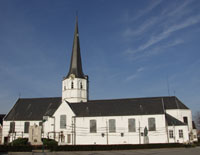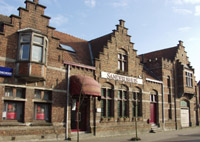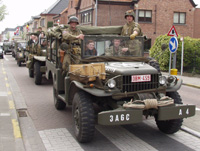The Meetjesland in the north of East-Flanders, Belgium

Sleidinge
In the 13th Century the town was called Scleidingka or Sleydinghen or even Sleyne as it is indeed still called in the local dialects.
The region called Sleidinge was cut in two in 1248. It was then a wooded and swampy place. The eastern part belonged to the St Baafs Abbey of Ghent and the count of Flanders reigned over the other part. But this too was swept away in the awful violence of the French Revolution and it became one parish and at the same time one town of about 5000 inhabitants.
 |
In the church you can admire several paintings by Nikolaas de Riemaeckere and Jozef Pauwels. |
But before that Sleidinge was on numerous occasions the theater of military operations or it was sacked by French soldiers, calvinists and various gangs of privateers.
For instance on 5 June 1586 there was a massive raid: the whole town was ransacked and the village priest was taken hostage. His ransom, 800 guilders was clearly over the top because he was still a hostage in 1589. But in 1593 he reappeared to take up once again his duties in Sleidinge and this until his death around 1610.
In June 1592 it was decided to build a small fortress in Sleidinge near the Ten Mariënpade estate. This fortress came too late because on 29 December 1592 a gang of freeloaders attacked Sleidinge; 10 or 11 houses were burned down and several hostages were taken.
The year 1818 saw the birth in Sleidinge of a famous painter called Jozef Pauwels. He painted religious scenes, land and city scapes and portraits. You can admire some of his (wall) paintings in the churches of Evergem, Sleidinge, Wetteren and Zelzate. He liked working together with August Ottevaere from Evergem. He died in Ghent in 1876.
Until the Industrial Revolution most of the inhabitants were (small) farmers and farm labourers. There was also a flourishing cottage industry. From 1880 onwards the population increased and soon there were several textile factories. Today only one of them, the "Calcutta" is still in business. It celebrated its 150th anniversary in 1998.
 |
Sanderus House is a tribute to Antonius Sanderus who was for a while the village priest of Sleidinge and who worked here on his Flandria Illustrata that made him famous. |
Today we could say Sleidinge is in many ways one of the suburbs of Ghent. It is merged with Evergem since 1/1/1977.
Our sources for most of the above:
"Streekgids Meetjesland", pp. 78-79
by Joris De Wildeman.
We are indebted to Mr. Paul Van de Woestijne for information on Jozef Pauwels in
a very interesting article entitled "Meetjeslandse Schilders in de Memoires
of J.B. Lybaert" (Meetjesland Painters in the Memoirs of J.B. Lybaert) and
published in the first issue of 2003 of an excellent quarterly publication called
"Heemkundige bijdragen uit het Meetjesland" (Regional Contributions
from the Meetjesland).
 |
Inside Sleidinge's church |
 |
Look a-here: Sleidinge's Time Square on 3 July 2005: old boys, old bangers and old timers. Sorry miss ! |
 |
On 23 April 2006, back in Sleidinge, we stopped a convoy of WW II military vehicles. Read here all about this incredible exploit. |

More pictures
Our Meetjesland
— Table of Contents
— Find something in this Meetjesland website

MijnPlatteLand.com
Most recent update : 22-04-2021
Copyright Notice (c) 2024